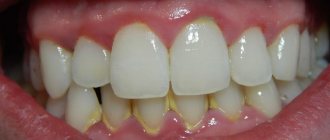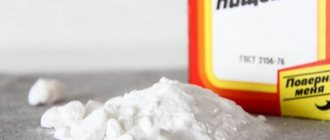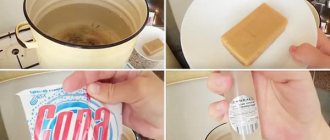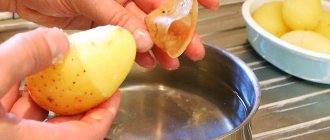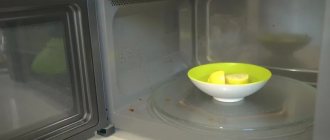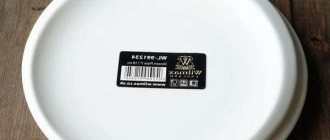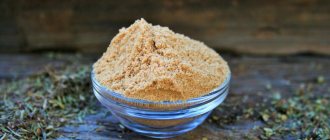There are universal products that can be used for medical purposes, in cosmetology, and in the household - these are baking soda and hydrogen peroxide, available to everyone. The effectiveness of their use in these areas has been tested by time and many, not succumbing to the advertising of modern cleaning products, continue to use safe “grandmother’s” products. There are simple and effective methods for cleaning kitchen utensils using baking soda (sodium bicarbonate) and hydrogen peroxide.
Benefits when used at home
Even before household products appeared, housewives used folk remedies to keep the kitchen clean. Popular among them were salt and peroxide. The household benefits of these products are as follows:
- effective fight against fat and old stains;
- environmental cleanliness;
- absence of harmful chemicals or allergens, which is important if there are children or allergy sufferers in the house;
- effective odor removal;
- disinfection, elimination of germs or bacteria;
- creating a whitening effect.
Baking soda in combination with oxygen peroxide helps remove complex stains and keep utensils and household appliances clean.
How to strengthen soda and peroxide
You can bleach things using peroxide, sodium bicarbonate and their mixture in pure form, or in combination with additional ingredients. They will help enhance the effect and remove more complex contaminants. Popular additives and their effects on fabric:
- salt is suitable for synthetic and natural animal fabrics (wool and silk). Helps to delicately cope with the problem of restoring whiteness;
- ammonia is suitable for all natural fabrics, eliminates unpleasant odors, enhances the effect of the basic solution;
- mustard powder is also universal in use and can be added to mixtures to whiten any items;
- Potassium permanganate can gently wash any white item.
Fact! Mixing store-bought products with homemade formulations can have the opposite effect, leading to yellowing of the material and damage to things.
Action
Baking soda and peroxide react to form a clear liquid. The molecules of this alkaline solution act on acids and eliminate them. Due to bactericidal, microbes or bacteria contained on the surface are eliminated.
The two products can also be combined with salted water or alcohol. These components are added to a solution of soda and peroxide to enhance the cleaning effect or add shine. However, they must be washed with gloves to avoid irritation on the skin.
Lifehacks. How to remove stains from clothes in simple but effective and natural ways
Their main advantage is that they are inexpensive, are often already available in the kitchen or medicine cabinet, and effectively deal with the problem without damaging the fabric. Remember, the sooner you start dealing with a dirty stain, the easier and faster you will get rid of it!
Dandelions, rapeseed, pollen
A universal remedy to get rid of traces of dandelions, rapeseed and pollen of other flowers on clothes is ammonia:
- Pour 1 tablespoon of ammonia onto a cotton pad, press it onto the contaminated area and leave for 20-30 minutes. Then you need to wash your clothes in the usual way.
Another simple but quite effective remedy:
- fresh lemon juice or citric acid diluted in water and apply to clothes and leave for 20-30 minutes.
For old stains, a paste of onion and glycerin should be suitable:
- Take regular onion, grate it finely, add a little glycerin to the juice and leave it on the clothes for half an hour. Then rinse off and apply a cotton pad with ammonia.
Greens and grass
The xanthophyll and carotenoid pigments found in grass are very similar to natural cotton fibers, allowing the stain to penetrate deeply and bind to the threads in the fabric - which is why grass stains are usually quite difficult to remove. But we have several effective ways:
- ½ cup white vinegar, 2 cups cold water and some laundry detergent.
Pour white vinegar onto the stain and use a sponge or old toothbrush to scrub the stain. This helps separate dirt from the fibers of the fabric. Then pour cold water and powder onto your clothes and leave for 15-20 minutes. Then wash the clothes by hand in fast water. It is extremely important that you do not use hot water in this process as this will only harden the stains.
Simple baking soda works well for grass stains on jeans. It consists of sodium bicarbonate, which reacts with organic stains. To remove grass stains from jeans, you will need a laundry stain remover with baking soda, vinegar, dish soap, and water:
- 3 tablespoons baking soda, 1 cup water, ½ cup vinegar, dish soap.
Mix baking soda with a tablespoon of water to form a thick paste. Apply a thick layer of paste to the stain. In a bowl, combine vinegar and one cup of water and add a drop of dish soap. Apply the solution to your clothing and rub the stain vigorously with a toothbrush, then rinse your jeans with warm water.
Sweat stains
Aspirin, which can be found in almost any home medicine cabinet, works great for sweat stains on clothes. It is used to treat colds, reduce fever and pain, but few people know that aspirin is also an excellent stain remover that effectively removes yellow sweat stains even from white things! Simple, convenient and sometimes more effective than bleach.
- Grind several aspirin tablets into powder (depending on how large the stain is), wet the contaminated areas on the clothing with water and apply the resulting powder on both sides. Leave the mixture on the clothes for an hour and then wash by hand with 72% laundry soap.
To prevent sweat stains from becoming embedded in clothing, we recommend adding a few tablespoons of white vinegar or the same aspirin powder to the washing machine each time you wash it.
- Very fresh stains are easily removed by a mixture of liquid soap and hydrogen peroxide in a 1:2 ratio.
Oil and grease stains
If you have stained your clothes with something greasy, the following products will also come in handy:
- All you have to do is apply cornstarch or salt to a fresh stain, set the clothes aside for a couple of hours, then rinse in water and baking soda, leave in it for another 15-20 minutes and then wash in your usual way. Tooth powder, baby powder or talcum powder can also be used as a substitute.
- Ammonia alcohol works well with old stains by moistening a cotton pad and treating the fabric. Ammonia has a specific smell, so you should rinse the item thoroughly afterwards.
If the stain is deeply ingrained, you will have to use aggressive methods:
- Dilute ammonia and turpentine in equal proportions, moisten a cotton pad with the mixture and leave the clothes for several hours, periodically go over the dirty area with an old toothbrush, then rinse off the product and wash the item.
- The above method will not work for delicate fabrics, so try dropping a few drops of glycerin onto the greasy stain, soak the fabric thoroughly and leave for 30 minutes. You can also prepare a mixture based on glycerin, to which ammonia and water should be added in equal proportions. Then simply wash the item.
Stains from berries and fruits
Bright stains from berries are very difficult to completely remove from clothing. While we still have ways to deal with fresh ones, old stains, unfortunately, will probably not disappear anywhere, although they will noticeably lighten. For multi-colored clothes, this result may be acceptable, but you will most likely have to get rid of the white item.
The first method is suitable for rough fabrics:
- For a bucket of boiling water, we need an incomplete glass of washing powder, two tablespoons of dry bleach and two tablespoons of sunflower oil. As soon as the mixture is prepared, turn off the heat and throw the dirty clothes into a bucket, where we leave it until the water cools down. Then rub the stains well with laundry soap and diligently scrub with a brush.
- If you plant a stain and immediately notice it, you need to immediately boil water and pour a stream of hot water onto the stain until it disappears.
But in this method there is a risk of damaging the fabric, if yours does not survive boiling water, we move on:
- Mix peroxide and ammonia in a 1:1 ratio and apply the solution to the stain; after a while it should disappear.
- Dilute one tablet of hydroperite in half a glass of water and pour it onto the dirty area
- Soak a cotton pad in ammonia and rub it thoroughly onto the stain.
Such methods should help remove stains from delicate fabrics, if not blueberries, then orange juice for sure. But we have one more powerful tool in stock:
- For 20 grams of 95% alcohol, take 2 grams of citric acid, heat the mixture to 40 degrees and pour it onto the stain. After the stain has disappeared, it should be rubbed again with a solution of ammonia and washed in the usual way.
Great for removing beetroot stains...milk!
- Heat it to 50-60 degrees and soak things in warm milk for several hours and immediately rinse thoroughly. This method is very soft and suitable for any fabric.
Wine stains
A weak solution of vinegar helps get rid of a fresh stain, and if this is too harsh a liquid for your delicate silk blouse, then a mixture of glycerin and eggs will help:
- Mix egg yolk and glycerin in equal proportions, using a cotton pad or sponge, apply the mixture thickly to the stain and leave for half an hour. After this, rinse the mixture in warm water.
- You can also remove a wine stain from colored fabric with a weak solution of potassium permanganate, in which you need to soak the clothes for a few minutes, and then treat the stain with a solution of hydrogen peroxide at the rate of 1 teaspoon of peroxide per glass of water.
Tea or coffee
Usually, a tea stain can be washed off with plain warm water, but if this is not your case, then here are a few more simple but effective methods, one of which will definitely suit you!
- You can try to get rid of the stain by rinsing in a solution of water with 5% hydrogen peroxide or white table vinegar;
- Fresh stains respond well to a mixture of water and alcohol in a 2:1 ratio;
- If the fabric allows, it can be doused with a stream of boiling water;
- For old stains, make a solution of citric acid: 20 g per 1 glass of warm water, moisten the stains with it and when they disappear, rinse everything thoroughly in water.
Some useful tips
- Before removing the smell of urine from a carpet using household chemicals, you should carefully prepare: put on gloves, a protective respirator, and remove children and animals. It is important to clean in a well-ventilated area to prevent chemicals from harming your health;
- In some stores you can find special products for removing urine odor. Follow the instructions when using them.
- To prevent a small puppy from getting the rug wet, place a special oilcloth under it and lay a diaper on top.
- Don't leave wet marks. Always dry them with a hairdryer or iron. Moisture will promote the appearance of mold and unpleasant odors.
- Do not use fragrances such as perfume, coffee, parsley, etc. They will only cover up the unpleasant odor for a short time, and the mixture of the aromas of urine and perfume is not very pleasant.
Rinsing your mouth with peroxide
One of the effective methods for whitening enamel at home is rinsing your mouth with hydrogen peroxide. To do this, you need to prepare a solution: peroxide and simple chilled water are mixed in a one-to-one ratio. You should rinse your mouth with the prepared preparation for a minute after each brushing of your teeth with toothpaste.
Each time it is necessary to prepare a new peroxide solution. When rinsing, it should not be in contact with the mucous membrane for a long time; after the procedure, you should rinse the mouth with water. To increase the effectiveness of hydrogen peroxide, the crowns should be treated with a remineralizing gel after each rinse.
You need to whiten your teeth with diluted hydrogen peroxide every day for a week. Afterwards, you need to take a break for 10–14 days, after which you can resume the whitening course.
Teeth rinse recipe
To avoid rinsing your mouth with a strong-smelling peroxide solution, you can prepare a flavored mouthwash.
Recipe for preparing a flavored mouthwash based on hydrogen peroxide for teeth whitening at home:
- Take an empty dark glass bottle. Plastic containers cannot be used, as they interact with essential oils.
- Pour 200 ml of distilled or filtered water into the bottle.
- Add 120 ml of hydrogen peroxide (3%) to the water.
- Mix 15 drops of essential oil with 1 tbsp. l. honey
- Place all ingredients in a bottle and mix them thoroughly.
You can rinse your mouth with a peroxide-based solution in courses of two weeks, after each course you must take a break.
The following essential oils are suitable for making scented bleach:
- carnations;
- peppermint;
- grapefruit;
- rosemary;
- sweet orange.
Preparing for the teeth whitening procedure
To minimize the harm from peroxide, it is necessary to prepare your teeth for the whitening procedure:
- take a course of vitamins and mineral complexes: Calcium-D3 Nycomed, Kalcemin;
- reduce the amount of sweets consumed;
- at least a week before the procedure, stop eating too spicy, hot or sour foods;
- Brush your teeth for a month with special medicinal pastes: Lacalut, Splat;
- For 1.5 months, include in your diet foods that contain a lot of calcium and fluoride: seafood, milk, herbs, vegetables.
Before home whitening, it is advisable to consult with a dentist so that he can assess the condition of the enamel and make a conclusion about the feasibility, usefulness and safety of the procedure. Only a dentist can determine whether it is possible to whiten teeth with hydrogen peroxide without compromising their functionality in a particular case or whether it is better to resort to more professional and gentle methods.
How to prepare a soap-soda solution for disinfection
For the solution you need 72% laundry soap, drinking water, baking soda or soda ash.
Proportions of ingredients for preparing detergent:
| Means | Soda (g) | Soap (g) | Water (l) | Other Ingredients |
| Solution 1% | 100 | 100 | 10 | |
| Solution 2% | 200 | 200 | 10 | |
| For dishes | 20 | 75 | 1 | 20 g dry mustard |
| For walls, floors | 200 | 25 | 5 | |
| For toys | 25–40 | 50 | 1 | |
| Mercury decontamination | 60 | 60 | 2 |
A soda-soap solution quickly breaks down fats, dirt, shells of viruses, microbes, and fungi. The product also forms a film, blocking the access of oxygen to infections.
Instructions for preparing washing soda:
- The soap is ground with a grater.
- Place a pan of water on the fire, add soap, stir until the shavings dissolve.
- Bring to a boil, add soda, stir, simmer for 10 minutes.
- Add mustard, stir, turn off the stove.
- The product is cooled and poured into a storage container.
According to the instructions, caustic soda is mixed only with water.
Caustic doses:
| Application of the product | Soda | Hot water (70–90 ºC) |
| At home | 1 g | 100 ml |
| In veterinary medicine (prevention) | 40 g | 1 l |
| In areas of infection (10% solution) | 100 g | 1 l |
Caustic is used to disinfect in the absence of animals or people.
To watch videos on the topic:
Cleaning the brushes
Do you know how much bacteria accumulates on a toothbrush? Scientists from England have calculated that at least 100 million! Don't you think something needs to be done about this?! For example, rinse the brush well.
To do this, just dip it in peroxide for 2 minutes and then rinse well.
For reference: it is recommended to change toothbrush heads every month.
How to choose a method for cleaning a frying pan
To properly clean an old frying pan from carbon deposits, first of all, determine what material it is made of. There are cast iron, aluminum and stainless steel frying pans.
In modern industry, cookware with non-stick coating is gaining increasing popularity. She requires careful and delicate care. Such pans are easy to clean, as their surface protects against the formation of carbon deposits on the dishes.
Recommendations from experts
Manufacturers of cookware recommend adhering to rules that help extend the life of the frying pan. It is important to follow preventive measures that prevent further contamination.
- When cooking and stirring food in a frying pan, you must use a wooden or plastic spatula.
- Use cleaning powders, scratching sponges, and scrapers as little as possible. This will prevent scratches on the inside of the pan.
- If the frying pan is often washed in the dishwasher, then you must clean it by hand once a month. In this case, you can easily notice the appearance of soot, which can be easily eliminated at the initial stage of its manifestation.
- Melamine sponges are well suited for cleaning ceramic products and enamel dishes. But they can only clean the outside.
- An aluminum frying pan should never be rubbed with an iron sponge. The damaged surface quickly oxidizes and the oxide gets into the food. Which will negatively affect human health.
- Baking soda or coarse salt helps get rid of rust on an old frying pan. After washing, be sure to heat the dishes so that the food does not burn.
Hydrogen peroxide + vinegar
When combined, they form peracetic or peracetic acid. It is registered as a powerful disinfectant and bleaching agent. But in its concentrated versions it irritates the skin and mucous membranes, is fire hazardous and even explosive.
Not the best cleaning product for a young chemist, would you agree? But in the presence of water, this acid turns back into peroxide and vinegar.
And we will have a lot of water, since we use solutions, not pure substances. But why take the risk?
We use soda with hydroperite in the bathroom:
- In pharmacies you can buy perhydrol, which in equal proportions with water will help you cope with mold and mildew, which often occurs on the walls and ceiling in the bathroom. This occurs due to high humidity.
- Every housewife has encountered the fact that the curtain in the bathroom is not easy to clean from mold stains. Now you don’t even care about this problem. When washing, add one bottle of peroxide to a container of water - after half an hour, you will see a new, clean curtain that does not have any unnecessary odors and there will not be a single speck of mold or mildew on it
- Another advantage of a substance based on perhydrol is the removal of rust from all plumbing fixtures. To remove these hated stains, you just need to mix water with peroxide in one bowl, 100 mg each. After this, apply the drug to the stain and leave for half an hour. After this time, you will be stunned by the results.
How to remove dried traces?
Before removing dried traces of dog urine, it is recommended to carry out preparatory work:
- Using a stiff, dry brush, work the stain to remove the crust.
- Use a vacuum cleaner to collect everything that was crumbled with a brush.
- Place a rag under the carpet and thoroughly wet the contaminated area with a wet sponge (carry out the manipulation several times).
You should prepare for the fact that you won’t be able to remove the disgusting smell and stain the first time. You will have to carry out several cleansing procedures.
Dilute dishwashing detergent in a glass of water until a thick foam forms. Then pour the mixture onto the stain, rub in a little and leave for at least an hour. Afterwards, blot the stain with a cloth or paper towel. It is advisable to press as hard as possible on the carpet so that as much liquid as possible comes out.
To completely remove the liquid, it is recommended to additionally treat the stain with a vacuum cleaner. Repeat the procedure until the stain completely disappears.
REFERENCE! When the stain is already old, it is better to entrust this matter to professionals. A professional dry cleaner offers a service where professionals can come to your home, or you can take the carpet to the laundromat.
Pet stores offer liquid consistencies and special powders that get rid of old stains. Each product is used exclusively according to the instructions, which must not be violated under any circumstances.
